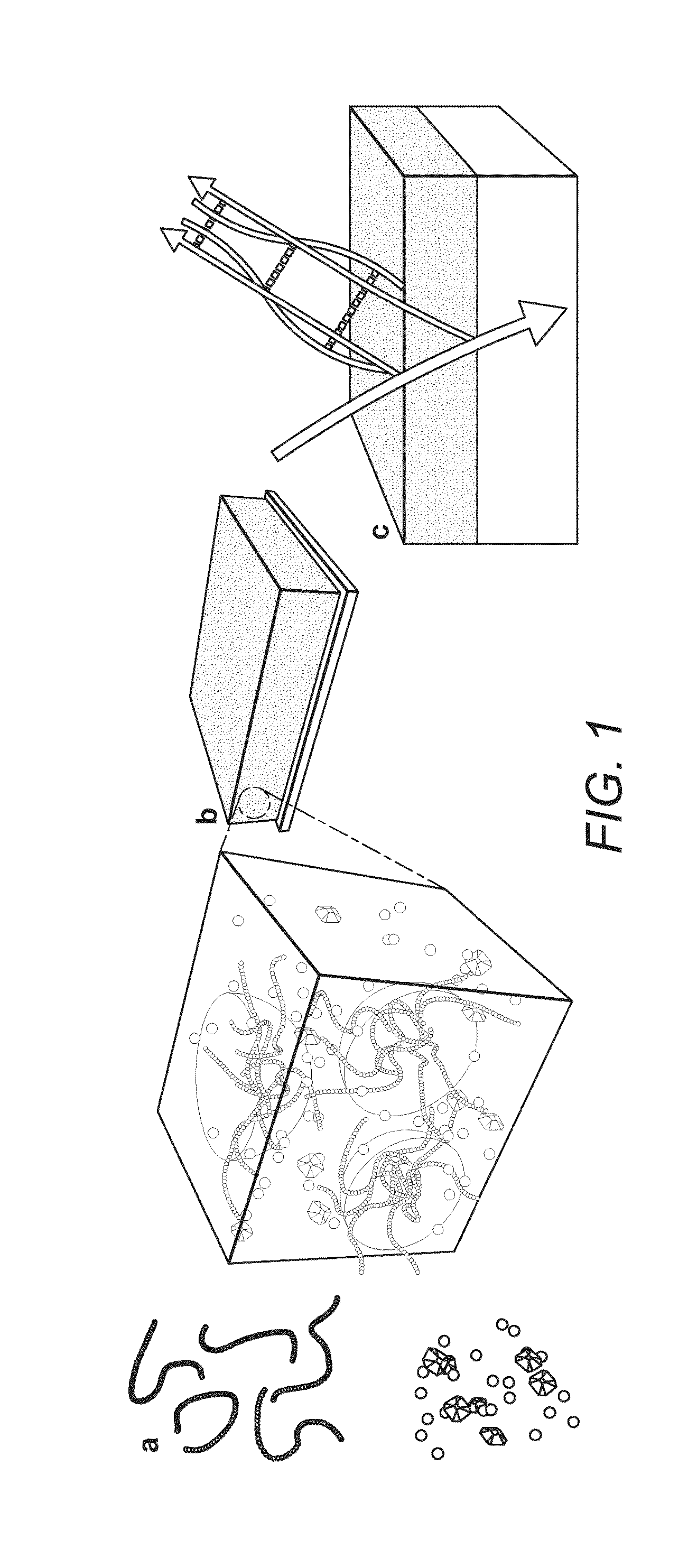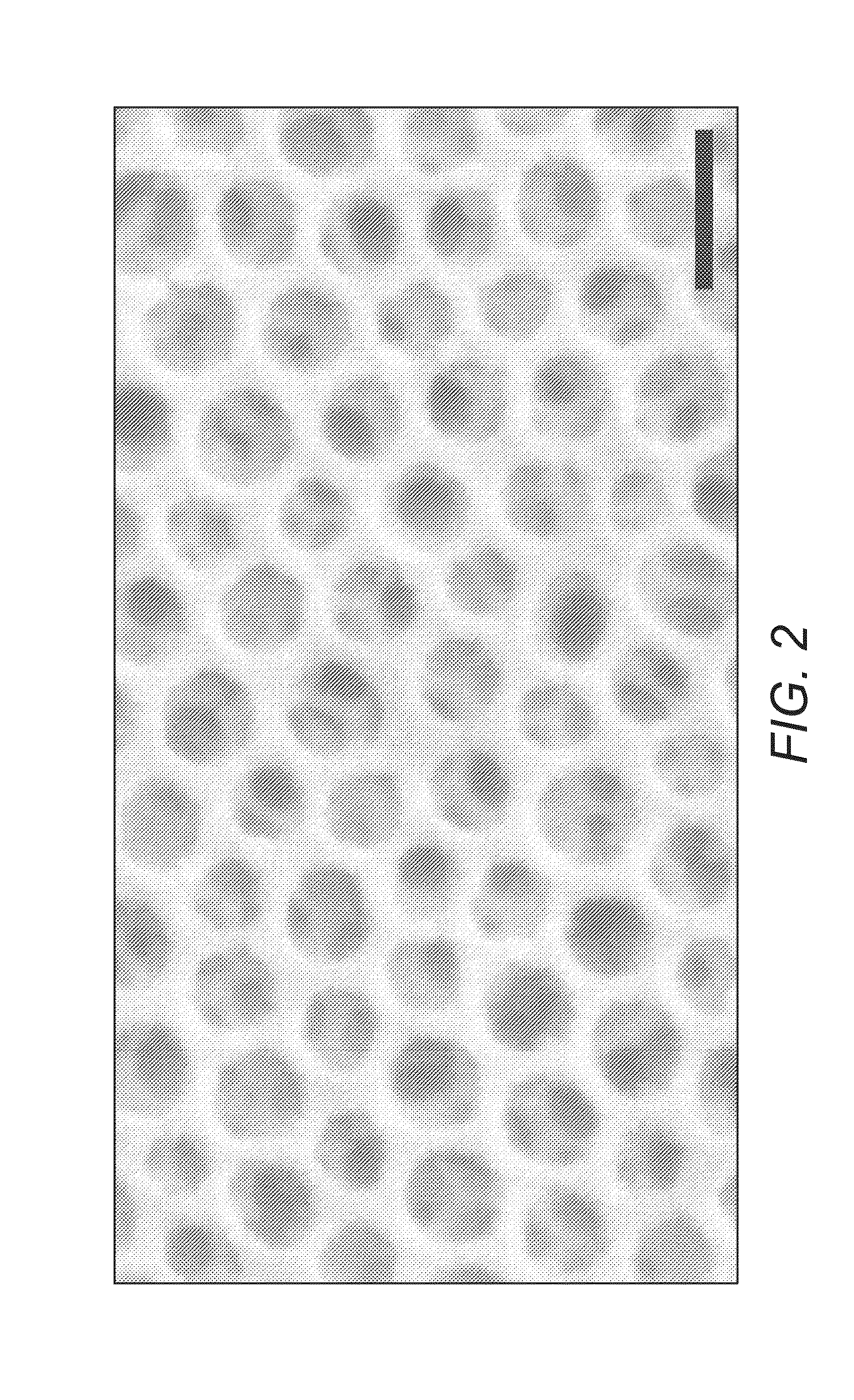Mesoporous inorganic coatings with photocatalytic particles in its pores
a technology of photocatalytic particles and pores, applied in the direction of anti-reflective coatings, physical/chemical process catalysts, instruments, etc., can solve the problems of affecting the application of broad-band anti-reflective coatings on low-index substrates, affecting the application of commercial products, and affecting the implementation of commercial products. achieve the effect of effective anti-reflective properties and effective self-cleaning properties
- Summary
- Abstract
- Description
- Claims
- Application Information
AI Technical Summary
Benefits of technology
Problems solved by technology
Method used
Image
Examples
example 1
Variation of Porosity
Preparation of Block Co-Polymer
[0068]A high molecular weight block copolymer—poly(isoprene-block-ethylene oxide) (PI-b-PEO) was prepared according to the method of Allgaier et al8 and was dissolved in an azeotrope mixture of toluene and 1-butanol. 8 Allgaier, J., Poppe, A., Willner, L., and Richter, D. Macromolecules 30, 1582-1586 (1997).
Preparation of Silica-Based Sol
[0069]An aluminosilicate sol was prepared separately by the step-wise hydrolysis of a silicon / aluminium alkoxide mix (9 / 1 molar ratio), in which: 2.8 g (3-glycidyloxypropyl)trimethoxysilane (98%,Aldrich) and 0.32 g aluminum-tri-sec-butoxide (97%, Aldrich) were mixed with 20 mg KCl (TraceSELECT, Fluka) and promptly placed into an ice bath. In a first hydrolysis step, 0.135 ml of 10 mM HCl was added dropwise in 5 s intervals at 0° C. and stirred for 15 min. After warming to room temperature, 0.85 ml of 10 mM HCl was further added dropwise.
[0070]A first set of experiments were conducted to determine t...
example 2
Variation of Pore Size
[0079]Using the above methodology, it was possible to prepare coatings from solutions fabricated with polymers of different polymer weight content, as follows:
ExamplePolymerMn (kg mol−1)Wt % PEO2API-b-PEO3434.428.02BPI-b-PEO9291.631.5
[0080]FIG. 2 shows the morphology of the film with similar inorganic loading as in Example 1 but with an increased PI molecular weight.
[0081]In this Example the copolymer had an increased PI chain length of 62.7 kg mol−1. The increase in chain length resulted in 53 nm-wide pores. This increase is in good agreement with scaling laws governing polymer chains in a good solvent. The radius of gyration of the pore forming PI block scales by a factor of 1.59 when increasing the molecular weight from 24.8 to 62.7 kg mol−1, which is consistent with the pore size determination by SEM image analysis.
example 3
Variation of Chemical Route to Porous Skeleton
[0082]In another experiment the materials route to the porous skeleton is altered. Most common pathways for the low refractive index inorganic components involve sol-gel chemistry with hydrolysis and condensation of the precursor chemicals. There are several non-hydrolytic alterations, where the precursor reaction takes place in an organic solvent under the exclusion of water.9 9 Sol-Gel Material: Chemistry and Applications, J. D. Wright, N. A. J. M. Sommerdijk, P. O'Brien, D. Phillips, CRC Press, 1st edition (2000)
[0083]Instead of following the standard routes of hydrolytic or non-hydrolytic sol-gel chemistry, an alternative precursor material is used, namely poly(methyl silsesquioxane) (PMSSQ) copolymer.10 In this case the PMSSQ copolymer is dissolved in 1-butanol, mixed with the block copolymer solution. The further processing (annealing and etching) then follows the route explained in Example 1. 10 S. Kim, J. Cho, K. Char, Langmuir, ...
PUM
| Property | Measurement | Unit |
|---|---|---|
| Fraction | aaaaa | aaaaa |
| Fraction | aaaaa | aaaaa |
| Fraction | aaaaa | aaaaa |
Abstract
Description
Claims
Application Information
 Login to View More
Login to View More - R&D
- Intellectual Property
- Life Sciences
- Materials
- Tech Scout
- Unparalleled Data Quality
- Higher Quality Content
- 60% Fewer Hallucinations
Browse by: Latest US Patents, China's latest patents, Technical Efficacy Thesaurus, Application Domain, Technology Topic, Popular Technical Reports.
© 2025 PatSnap. All rights reserved.Legal|Privacy policy|Modern Slavery Act Transparency Statement|Sitemap|About US| Contact US: help@patsnap.com



